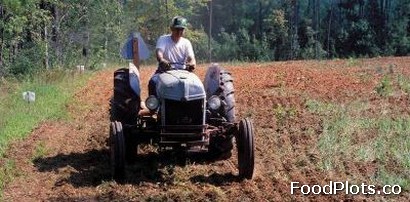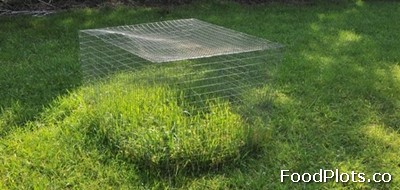Hunters and wildlife managers know that food plots are powerful attractants for both game and non-game species, especially white-tailed deer, upland birds and waterfowl, but sportsmen do not know how to plant a food plot correctly. Proper plot preparation is not always possible because sometimes access and food plot preparation and planting equipment is limited, but I can assure you that a spring or fall food plot will not reach it’s full supplemental-forage-providing potential for wildlife if it is not planted properly.

Research has found that well-planned food plots offer significant, measurable benefits for whitetail deer. Other game animals respond readily to plots planted to appropriate forage, too. With this is mind, let’s take a step-by-step approach on how to plant food plots for whitetail deer and other wildlife. Before jumping ahead too much, the importance of selecting a good location for your food plot should not be understated. Look for fertile soil on level ground that is close to cover, ideally near areas that wildlife often frequent.
After identifying the food plot location, first collect and send off your soil samples for testing. Next, prepare the seedbed by plowing and/or disking the soil. After initial breaking, lime and fertilizer should be incorporated, as recommended by the soil test, into the soil at this time. Next, plant large seeds such as wheat, oats, and peas into the prepared seedbed, then lightly disk/drag seeds into the food plot, covering approximately 1 inch deep.
The next step will be to firm the seedbed with a cultipacker. This is not completely necessary for large seeds, but it is an especially important step when preparing to plant small seeds such as ladino clover. After packing, plant small seeds such as clovers and alfalfa, then cultipack the seedbed a second time to ensure good, firm seed-to-soil contact. This will improve germination rate, provide more food for wildlife, and allow you to get the most from your food plot.
The leaves and seeds of legumes serve as high quality forage for a variety of wildlife species, but special steps must be taken if legumes are used in food plots. If legume seeds are desired, then treat the seeds with the appropriate innoculant before planting or buy pre-inoculated seed. Proper seed inoculation helps ensure food plot success, can save on fertilizer costs, and can save you money.
The steps above cover the pre-growth steps on how to plant a food plot for game such as dove, quail and turkey, but if the plot is for whitetail deer then it’s not over after the seeds are in the ground. Planting success and use of deer food plots should be monitored using exclusion cages. Exclusion cages allow managers and hunters to observe how much forage is being consumed by whitetail deer over a period and to evaluate the success of the planting. If deer are overgrazing a plot immediately after germination, then more acreage should be planted int the future.

Exclusion cages for food plots for whitetail deer can be made from a variety of materials. Landowners can use cages fabricated from cattle panels or welded-wire that are two to four feet in diameter, or even from chicken wire wrapped around four stakes driven into the ground. Food plots for deer can be difficult to establish in areas that have high whitetail densities. Exclusion cages are a “must do” for gauging deer use of supplemental forage.
There are numerous commercial food plot mixes available for wildlife, though most target the hunter. Some food plot seeds are well worth what there cost, but some are not. Most commercial plot blends contain quality seed that can grow solid food plots if planted properly at the right time on the proper site. Many food plot mixes are great, but they may not be great for your area. Do your homework before dropping a wallet full of cash on a mix that does not perform in your area.
Before planting, hunters and managers should consider food plot placement, size, shape and distribution across a property carefully. Although the size, shape and distribution of food plots vary for different wildlife species, knowing how to plant a food plot is the key to wildlife management and hunting success. Do it the right way from the start and both you, your food plots and the wildlife on your property will be in much better shape.
Thanks for the cursory review on the how-to of food plots. Thinking of planting a plot or two on our property to supplement deer.